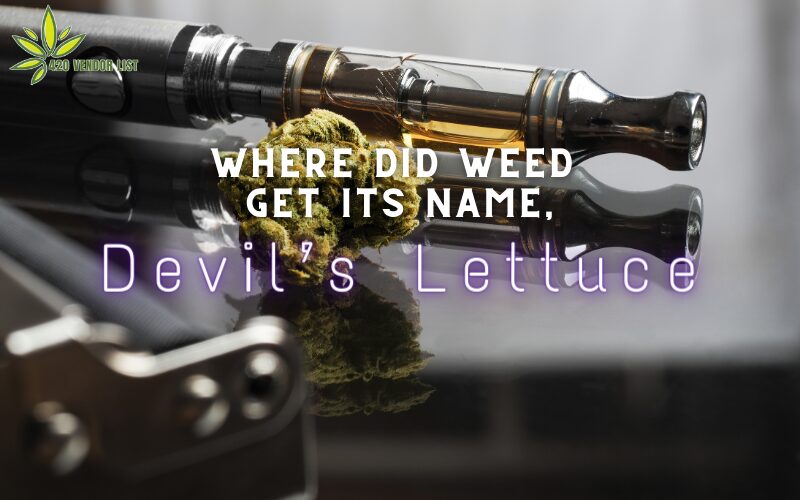
Something that might catch novice cannabis consumers off-guard when entering into the cannabis industry for the first time, is the insane amount of code names or nicknames associated with cannabis. This can be a pseudo name for the plant or bud itself, or it could be referring to the act of smoking, the amounts, types, consumption effects, and the people who smoke cannabis. All of these different things have, over time, generated a different form of slang and continue to evolve and grow, to this day, as the acceptance and slow-building legalization of cannabis becomes reality.
There are many unique and colorful nicknames associated with cannabis that could be explored in-depth, however, the one of focus and much intrigue is the term, “Devil’s Lettuce”. Deriving its roots from racist propaganda, the name Devil’s Lettuce has a complicated and tumultuous past. For individuals interested in learning more about where weed got’s its most notorious and edgy name, stay tuned. This article explores the complicated history of cannabis while also spending some time highlighting some related and investing cannabis jargon.
Where Does The Name, “Devil’s Lettuce”, Come From?
When first analyzing the term, “Devil’s Lettuce”, there is some aspect to this terminology that lends some credence. For example, the “lettuce” part refers to the green coloration of the cannabis plant as well as its overall visual similarities with the vegetable. However, things take a more negative turn when it comes to the origins of the “devil” part.
Some nicknames or codenames for cannabis came about out of necessity due to the illegal status of the plant. To keep the selling, possession, and trafficking of weed secret, code names were vital to keeping business flowing. Unfortunately, those who sought to tarnish the name of the cannabis plant use that system to their advantage and created inflammatory propaganda designed to slur the name of cannabis and deter anyone from trying it. Any inherent ties or correlations with the devil are more than likely set to deter people and create a negative stereotype in their heads. Not only was this to trigger thoughts about the dangers of cannabis but also as a means to place negative associations on the people who smoked it.
But, once the veil is pulled back, the trail is revealed to be a little deeper and more treacherous. Stepping back in time, all the way back to the late 19th century, the word “marijuana” was introduced to the United States by the Spaniards in their pursuit of importing cannabis to Mexico for use as industrial hemp. At first, the word was just that, a word that didn’t hold much meaning other than representing what it was. However, towards the end of the Mexican Revolution, as many citizens fled to the US to seek migrant labor, the beginnings of racist and anti-immigrant sentiment spread throughout the US.
Many articles from that time were unearthed, revealing the slanderous news articles that portrayed marijuana as inciting violence among Mexicans who smoked the plant. Leading to the illogical conclusion that there were inherent ties to violence and cannabis. This warped logic and racist sentiment persisted and the campaign to slander cannabis’s name and associate it with violent and nefarious activities rose to the point of referring to the plant as the Devil’s Lettuce.
The Consequences Of Prohibition
If there is one true antagonist for the treatment of marijuana, it was a man named Harry J. Anslinger. He was a government official having served five presidents in his tenure that made it his duty to spend his career placing a bad name on cannabis and misrepresenting its consumers. An overzealous prohibitionist, Anslinger was unrelenting in his attacks against cannabis and in perpetuating negative stereotypes on the people who consumed cannabis.
Cannabis was hit especially hard in the 1930s as various types of anti-cannabis propaganda surfaced through various films and propaganda campaigns. Many of the allegations set that cannabis perpetuated certain tragic behaviors like suicide, rape, murder, and a descent into madness. It should be noted that it is almost undeniable that Anslinger’s attacks were racially motivated as he suggested in many instances that the consumption of cannabis was driven by Black people and people from Mexico. He even went so far as to insinuate that cannabis was used by these groups to swindle and entice white women and lead them down the wrong path. Every single one of these claims has since been disputed and concluded to be purely racist propaganda.
Although it is not entirely clear where the true origins of “Devil’s Lettuce” come from, it is clear that much of the rhetoric surrounding it was backed by racist sentiments and the paranoia surrounding a plant that few truly had a full grasp of understanding. Along with some other terms associated with cannabis, “Devil’s Lettuce” draws its roots from vilifying certain groups of people for an agenda with no backing. And, because of that, it’s best to leave the term “Devil’s Lettuce” in the dust, lost to the annals history.
What Are Some Other Nicknames For Cannabis Other Than “Devil’s Lettuce”?
On somewhat of a lighter note, there are some unique and creative nicknames or codenames for cannabis. For example, there are tons of names when it comes to referring to the plant itself like weed, bud, flower, Mary Jane, and pot—to name a few. But, there are also nicknames to refer to the various tools or methods of consumption like smoking a blunt or a wood. There are even terms out there to refer to people who smoke cannabis, like stoners which have a somewhat polarizing history as it was a derogatory term used to refer to people who smoked weed.
But, for the most part, the unique and colorful references and nicknames found within the cannabis industry showcase the creativity and ingenuity of the individuals operating within the industry and their staunch perseverance when it comes to cannabis and its beneficial and widespread applications.

